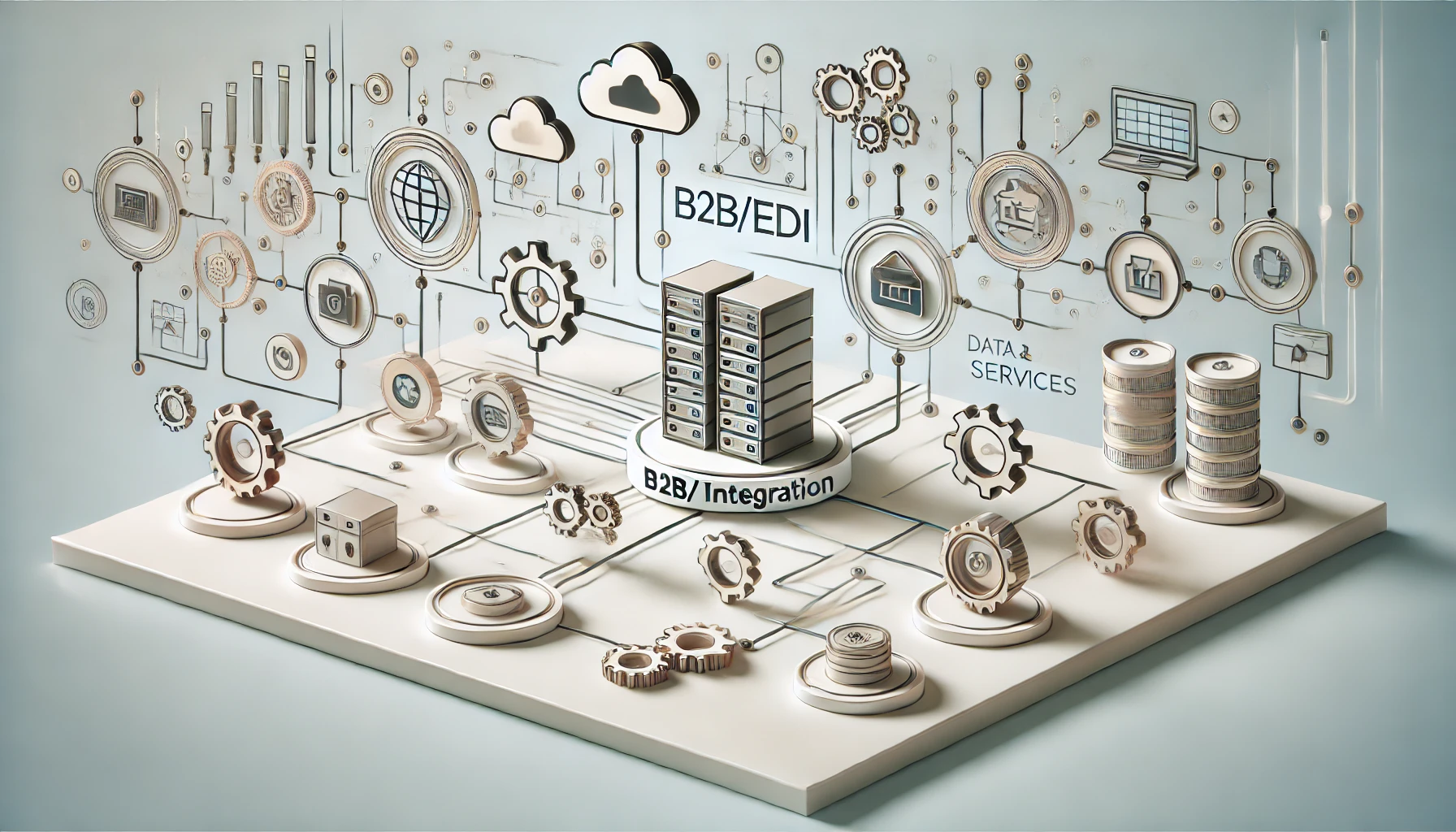To implement B2B/EDI integration services in your business, the initial steps can set the tone for a seamless integration process. Evaluating your company’s current systems, understanding the specific challenges that integration can address, and selecting the right solutions tailored to your needs are crucial starting points. However, the real key lies in how you navigate the complexities of implementation and ensure a smooth transition. Let’s explore the intricate steps involved in successfully integrating B2B/EDI services into your business operations.
Understanding B2B/EDI Integration
When implementing B2B/EDI integration services, understanding the fundamental concepts of B2B/EDI integration is crucial. B2B/EDI integration offers numerous benefits such as streamlined communication, reduced manual errors, and increased efficiency in data exchange between trading partners. However, it also presents challenges like complexity in implementation, data security concerns, and the need for ongoing maintenance.
One key aspect of B2B/EDI integration is adhering to industry standards and compliance regulations. Ensuring that your integration solution meets the necessary standards such as X12, EDIFACT, or AS2 is vital for seamless communication with partners and regulatory compliance. Non-compliance can lead to data breaches, legal issues, and loss of trust from partners.
Assessing Business Needs and Readiness
To effectively implement B2B/EDI integration services, the initial step involves assessing your business needs and readiness for such a transformation. Conducting a readiness assessment is crucial to determine if your organization is prepared for integrating B2B/EDI solutions. Start by identifying your specific business needs that can be addressed through integration. Consider factors such as the volume of transactions, types of data exchanged, and the complexity of partner networks.
Next, perform a comprehensive needs assessment to evaluate the resources, technology, and expertise required to support B2B/EDI integration. Assess your current IT infrastructure to determine its integration readiness. Look into your team’s skill set and determine if additional training or hiring is necessary to manage the integration process effectively.
Researching and Selecting Integration Solutions
When researching and selecting integration solutions for your B2B/EDI implementation, it is crucial to establish clear solution evaluation criteria tailored to your business needs. You should develop a structured vendor comparison process that considers factors such as functionality, scalability, compatibility, and support services. By meticulously assessing these aspects, you can ensure that the chosen integration solution aligns with your strategic objectives and operational requirements.
Solution Evaluation Criteria
During the process of researching and selecting integration solutions for B2B/EDI implementation, it is crucial to establish clear solution evaluation criteria to guide your decision-making. To ensure you choose the most suitable solution for your business, consider the following criteria:
- Scalability: Assess whether the solution can grow with your business and handle an increasing volume of transactions.
- Compliance: Verify if the solution meets industry standards and regulatory requirements to ensure secure data exchange.
- Customization: Evaluate the level of customization the solution offers to tailor it to your specific integration requirements.
- Ease of Use: Consider the user-friendliness of the solution to facilitate adoption and reduce training time for your team.
- Support and Maintenance: Look into the support services provided by the vendor and the ease of maintenance to address any issues promptly.
Vendor Comparison Process
Selecting the right vendor for your B2B/EDI integration needs is a critical step in ensuring the success of your implementation project. When comparing vendors, start by conducting a cost analysis to determine the financial implications of each solution. Consider not only the initial setup costs but also ongoing maintenance and support fees. Additionally, evaluate the scalability of the pricing model to ensure it aligns with your business growth.
Next, delve into feature comparison. Make a list of the essential features your integration solution must have and compare how each vendor meets these requirements. Look for capabilities such as data mapping, secure file transfer protocols, real-time visibility, and compatibility with various EDI standards. Assess each vendor’s track record in delivering these features effectively.
Moreover, consider the vendor’s reputation, customer support quality, and implementation timeline. Request demos or trial periods to test the solutions firsthand. Prioritize finding a vendor that not only meets your technical requirements but also offers reliable support and a seamless onboarding process.
Developing an Integration Strategy
When developing your integration strategy, focus on essential planning aspects such as defining clear objectives and identifying key stakeholders. Utilize effective data mapping techniques to ensure seamless communication and data flow between systems. These strategies are crucial for successful B2B/EDI integration services implementation.
Integration Planning Essentials
To develop a robust integration strategy for your B2B/EDI integration services, it is imperative to meticulously plan and define the essential aspects that will drive successful implementation. When crafting your integration plan, consider the following key points:
- Identification of Implementation Challenges: Conduct a thorough analysis to anticipate and address potential obstacles that may arise during the integration process.
- Adherence to Best Practices: Incorporate industry best practices to ensure efficiency, accuracy, and compliance with standards throughout the integration project.
- Realization of Integration Benefits: Clearly outline the specific benefits your business aims to achieve through B2B/EDI integration to align all stakeholders towards common goals.
- Strategic Project Timeline: Develop a detailed timeline that includes milestones, deliverables, and dependencies to track progress and ensure timely completion of the integration.
- Continuous Evaluation and Adaptation: Implement mechanisms for ongoing evaluation of the integration process, allowing for adjustments based on feedback and evolving requirements.
Data Mapping Techniques
Developing effective data mapping techniques is integral to crafting a successful integration strategy for B2B/EDI services. Data transformation plays a crucial role in ensuring that information is accurately exchanged between different systems. To achieve seamless integration, businesses must understand the mapping complexity involved in aligning data formats, structures, and semantics across various platforms.
When implementing data mapping techniques, consider the source and target systems’ data structures, field mappings, and any required transformations. Utilize mapping tools that allow for visual representations of the data flow and enable easy configuration of transformation rules. Additionally, establish clear data mapping rules and guidelines to ensure consistency and accuracy throughout the integration process.
Map out the data flow from the source to the destination, identifying any potential bottlenecks or points of failure. Test the data mapping thoroughly to validate the accuracy of transformations and verify that the integrated systems function as intended. By focusing on data mapping techniques and understanding mapping complexity, businesses can streamline their B2B/EDI integration processes and enhance overall operational efficiency.
Implementing the Integration Process
Implementing the integration process involves a series of critical steps that are essential for the successful alignment of B2B/EDI systems. To ensure a seamless integration, follow these key steps:
- Assess Current Systems: Begin by evaluating your existing systems to identify areas that require integration for efficient data exchange.
- Define Integration Goals: Clearly outline your objectives for process automation and workflow optimization to drive the integration strategy.
- Select Integration Tools: Choose the right software or platform that aligns with your integration requirements and supports B2B/EDI protocols.
- Develop Integration Plan: Create a detailed plan outlining tasks, timelines, and responsibilities to guide the implementation process.
- Execute and Monitor: Implement the integration plan systematically, monitor progress, and make adjustments as needed to ensure successful integration.
Testing and Optimizing Integration Services
Optimizing integration services is a crucial phase in the B2B/EDI implementation process. Performance testing plays a key role in ensuring that the integration services are functioning optimally. This involves evaluating the speed, reliability, and scalability of the integration solution under different load conditions. By conducting performance tests, you can identify and address any bottlenecks or issues that may impact the efficiency of your integration services.
User feedback is another critical aspect of testing and optimizing integration services. Gathering feedback from end-users about their experience with the integrated system can provide valuable insights into areas that require improvement. By incorporating user feedback into the optimization process, you can enhance the usability and overall satisfaction of the integration services.
Regularly monitoring and testing the performance of your integration services, along with gathering user feedback, are essential practices to ensure that your B2B/EDI integration is running smoothly and meeting the needs of your business effectively.
Frequently Asked Questions
Can B2b/Edi Integration Services Support Multiple File Formats?
Yes, b2b/edi integration services can support multiple file formats through advanced data transformation capabilities. This ensures seamless format compatibility, enabling efficient exchange of information regardless of the file type used, enhancing interoperability and communication in your business processes.
Are There Any Ongoing Maintenance Costs Associated With Integration Solutions?
Ongoing maintenance costs for integration solutions vary based on complexity and scope. However, investing in regular upkeep ensures system stability and data accuracy. While initial expenses exist, long term benefits include improved efficiency and streamlined operations.
What Security Measures Are in Place to Protect Sensitive Data?
To safeguard sensitive data, robust security measures like data encryption and access control are implemented. Encryption ensures data is unreadable if intercepted, while access control restricts unauthorized entry. These measures work together to fortify data protection.
How Can I Ensure Seamless Communication With Trading Partners?
Like a well-oiled machine, your partner relationships thrive on seamless communication strategies. Prioritize clear channels, standardized protocols, and regular updates to ensure efficient interactions. Foster trust and reliability through effective communication practices with trading partners.
Is Technical Support Available for Troubleshooting Integration Issues?
For troubleshooting integration issues, technical support is available. Ensure seamless communication with trading partners through integration testing. Streamline data mapping to resolve any integration challenges promptly. This strategic approach optimizes B2B/EDI integration services effectively.



